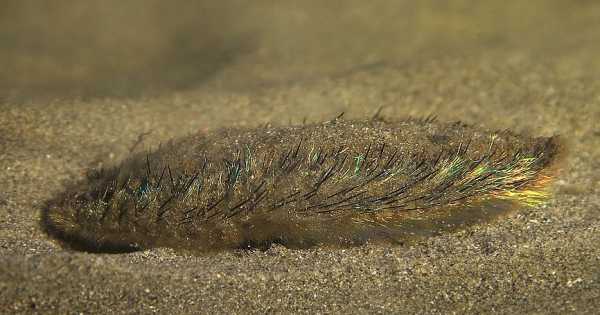seamouse
This is a 2 decimeter long that moves slowly over the sandy bottom of the seas. Here its searching for borrowed worms and dead animals. When a dead seamouse washes up on shore, it looks like a wet mouse, hence it's name "sea mouse".
Sea mouse
The most imporant way of defence of the seamouse are his camouflage greyish colors. But if seen from above the seamouse shows all kind of colors, that quickly change. This light effect deters fishes.
slow decline of the seamouse
The seamouse usedto be a often seen inhabitant of the North sea, but has almost completely dissapeared. The most important reason is the fishery, especially the bottom trawling. Bottom trawling is towing a fishing net along the sea floor, which not only kills the seamouse but its most important prey, the sea slug, as well.
sea mouse distribution
Sea mouse can be found in large parts of the seas. They can be found up to 2000 meter under the surface. The seamouse lives in the North Atlantic, the North Sea, the Baltic Sea and the Mediterranean. The defence to potential predators by using reflecting color works the best if the light comes from the same direction a the predator. In the depths of the ocean theres is no light, exept from light emitting fishes.
Probably here has the sea mouse the greatest benefits from its defence.
fotonic cristals of the seamouse
The hairs of the seamouse (also called the setae ) are covered with hexagonal fotonic cristals that reflect light and change it color. The small cristals reflect only the light in the direction it came from.

Worms, living in the sea. From Meyers, 1905
1 arrow worms or Chaetognatha
2 Rhynchonerella gracilis
3 Lineus kennelii, ribbon worm or proboscis worm
4 Dasybranchus caducus, a polychaetes or bristle worm
5 Discocelis tigrina, a flatworm
6 Ptychodera clavigera, a polychaetes or bristle worm
7 Sipunculus nudus, sipunculid worms or peanut worms
8 Chaetopterus variopedatus, a polychaetes or bristle worm
9 roggenbloedzuiger of Pontobdella muricata
10 Pseudobiceros undulatus, flatworm
11 Callioplana marginata, flatworm
12 Lineus molochinus ribbon worms or proboscis worm
13 Halla of pathenopeja
14 Bonellia viridis, Echiura, the trunk is only shown.
15 Euborlasia inmaculata, ribbon worms or proboscis worm
16 sea mouse or Aphrodita aculeata, a polychaetes or bristle worm
17 polymeria nebulosa
18 Eunice macrobranchia, a polychaetes or bristle worm
19 Eteone syphodonta
20 Nereiphylla paretti, a polychaetes or bristle worm
21 Yungia aurantiaca, flatworm
22 Serpula of Hydroides uncinata, a polychaetes or bristle worm

Marine worms of the North sea
Librairie J.-B, Baukkuere et Fils, 1906
1 seamouse or Aphrodite aculeata
2 Lepidonotus squamatus, Polynoidae
3 slender ragworm or Nereis pelagica
4 lugworm or Arenicola marina
5 Ross worm tubes of Sabellaria spinulosa, een borstelworm
6 peacock worm or Sabella pavonina
7 Keel Worm or Pomatoceros triqueter
8 Spirorbis carinatus
9 Echiurus echiurus

Seamouse in an aquarium: as the light comes from the side, the seamouse reflects the light back to the side. Here some fast chanching colors can be seen.

1 Tomopteris
2 Spirographis Spallanzanii
3 Protula intestinum
4 Aphrodite aculeata
5 Hydroides norvegicus
6 Lanice conchilega
7 Hermella Sabellariidae

Meyers konversation lexicon
This large German encyclopedia , from 1839 to 1984, is knowadays called "the Brockhaus encyclopedia". It had the be a universal encyclopaedia meant for a broad public. The first issue started in 1839 the last appeared in 1979 , entitled Meyers Enzyklopädisches Lexikon, with 25 volumes. On this website are shown:
cicades
calluna
Great capricorn beetle
tubeworms
brittle star
worms of the Northsea
The bottom of the wood
